Naked mole-rat
The naked mole-rat (Heterocephalus glaber), also known as the sand puppy,[4] is a burrowing rodent native to parts of East Africa. It is closely related to the blesmols and is the only species in the genus Heterocephalus of the family Heterocephalidae.[5] The naked mole-rat and the Damaraland mole-rat (Fukomys damarensis)[6][7] are the only known eusocial mammals, the highest classification of sociality. It has a highly unusual set of physical traits that allow it to thrive in a harsh underground environment and is the only mammalian thermoconformer, almost entirely ectothermic (cold-blooded) in how it regulates body temperature.[8]
| Naked mole-rat | |
|---|---|
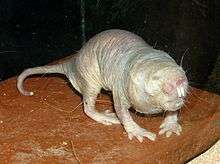 | |
| Scientific classification | |
| Kingdom: | Animalia |
| Phylum: | Chordata |
| Class: | Mammalia |
| Order: | Rodentia |
| Parvorder: | Phiomorpha |
| Family: | Heterocephalidae Landry, 1957; Patterson, 2014 |
| Genus: | Heterocephalus Rüppell, 1842[3] |
| Species: | H. glaber |
| Binomial name | |
| Heterocephalus glaber | |
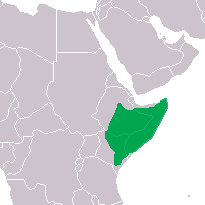 | |
| Distribution of the naked mole-rat | |
The naked mole-rat lacks pain sensitivity in its skin, and has very low metabolic and respiratory rates. While formerly considered to belong to the same family as other African mole-rats, Bathyergidae, more recent investigation places it in a separate family, Heterocephalidae.[9][10][11] The naked mole-rat is also remarkable for its longevity and its resistance to cancer and oxygen deprivation.
Description
Typical individuals are 8 to 10 cm (3 to 4 in) long and weigh 30 to 35 grams (1.1 to 1.2 oz). Queens are larger and may weigh well over 50 grams (1.8 oz), the largest reaching 80 grams (2.8 oz). They are well-adapted to their underground existence. Their eyes are quite small, and their visual acuity is poor. Their legs are thin and short; however, they are highly adept at moving underground and can move backward as fast as they can move forward. Their large, protruding teeth are used to dig and their lips are sealed just behind the teeth, preventing soil from filling their mouths while digging.[12] About a quarter of their musculature is used in the closing of their jaws while they dig—about the same proportion that is utilized in the human leg. They have little hair (hence the common name) and wrinkled pink or yellowish skin. They lack an insulating layer in the skin.
Physiology
Metabolism and respiration
The naked mole-rat is well adapted to the limited availability of oxygen within the tunnels of its typical habitat. It has underdeveloped lungs and its hemoglobin has a high affinity for oxygen, increasing the efficiency of oxygen uptake.[13][14][15] It has a very low respiration and metabolic rate for an animal of its size, about 70% that of a mouse, thus using oxygen minimally.[16] In response to long periods of hunger, its metabolic rate can be reduced by up to 25 percent.[14]
The naked mole-rat survives for at least 5 hours in air that contains only 5% oxygen; it does not show any significant signs of distress and continues normal activity. It can live in an atmosphere of 80% CO
2 and 20% oxygen. In zero-oxygen atmosphere, it can survive 18 minutes apparently without suffering any harm (but none survived a test of 30 minutes). During the anoxic period it loses consciousness, its heart rate drops from about 200 to 50 beats per minute, and breathing stops apart from sporadic breathing attempts. When deprived of oxygen, the animal uses fructose in its anaerobic glycolysis, producing lactic acid. This pathway is not inhibited by acidosis as happens with glycolysis of glucose.[14][15] As of April 2017, it was not known how the naked mole-rat survives acidosis without tissue damage.[17]
Thermoregulation
The naked mole-rat does not regulate its body temperature in typical mammalian fashion. They are thermoconformers rather than thermoregulators in that, unlike other mammals, body temperature tracks ambient temperatures. However, it has also been claimed that "the Naked Mole-Rat has a distinct temperature and activity rhythm that is not coupled to environmental conditions."[18] The relationship between oxygen consumption and ambient temperature switches from a typical poikilothermic pattern to a homeothermic mode when temperature is at 29 °C or higher.[19] At lower temperatures, naked mole-rats can use behavioral thermoregulation. For example, cold naked mole-rats huddle together or seek shallow parts of the burrows that are warmed by the sun. Conversely, when they get too hot, naked mole-rats retreat to the deeper, cooler parts of the burrows.
Pain insensitivity
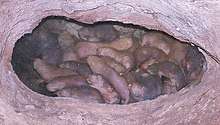
The skin of naked mole-rats lacks neurotransmitters in their cutaneous sensory fibers. As a result, the naked mole-rats feel no pain when they are exposed to acid or capsaicin. When they are injected with substance P, a type of neurotransmitter, the pain signaling works as it does in other mammals but only with capsaicin and not with acids. This is proposed to be an adaptation to the animal living in high levels of carbon dioxide due to poorly ventilated living spaces which would cause acid to build up in their body tissues.[20]
Naked mole-rats' substance P deficiency has also been tied to their lack of the histamine-induced itching and scratching behavior typical of rodents.[21]
Resistance to cancer
Naked mole-rats have a high resistance to tumours, although it is likely that they are not entirely immune to related disorders.[22] A potential mechanism that averts cancer is an "over-crowding" gene, p16, which prevents cell division once individual cells come into contact (known as "contact inhibition"). The cells of most mammals, including naked mole-rats, undergo contact inhibition via the gene p27 which prevents cellular reproduction at a much higher cell density than p16 does. The combination of p16 and p27 in naked mole-rat cells is a double barrier to uncontrolled cell proliferation, one of the hallmarks of cancer.[23]
In 2013, scientists reported that the reason naked mole-rats do not get cancer can be attributed to an "extremely high-molecular-mass hyaluronan" (HMW-HA) (a natural sugary substance), which is over "five times larger" than that in cancer-prone humans and cancer-susceptible laboratory animals.[24][25][26] The scientific report was published a month later as the cover story of the journal Nature.[27] A few months later, the same University of Rochester research team announced that naked mole-rats have ribosomes that produce extremely error-free proteins.[28] Because of both of these discoveries, the journal Science named the naked mole-rat "Vertebrate of the Year" for 2013.[29]
In 2016, a report was published that recorded the first ever discovered malignancies in two naked mole-rats, in two individuals.[30][31][32] However, both naked mole-rats were captive-born at zoos, and hence lived in an environment with 21% atmospheric oxygen compared to their natural 2–9%, which may have promoted tumorigenesis.[33]
The Golan Heights blind mole-rat (Spalax golani) and the Judean Mountains blind mole-rat (Spalax judaei) are also resistant to cancer, but by a different mechanism.[34]
Longevity
The naked mole-rat is also of interest because it is extraordinarily long-lived for a rodent of its size (up to 32 years[15][35]) and holds the record for the longest living rodent.[36] The mortality rate of the species does not increase with age, and thus does not conform to that of most mammals (as frequently defined by the Gompertz-Makeham law of mortality).[37] Naked mole-rats are highly resistant to cancer[38] and maintain healthy vascular function longer in their lifespan than shorter-living rats.[39] The reason for their longevity is debated, but is thought to be related to their ability to substantially reduce their metabolism during hard times, and so prevent aging-induced damage from oxidative stress. This has been referred to as "living their life in pulses".[40] Their longevity has also been attributed to "protein stability".[41] Because of their extraordinary longevity, an international effort was put into place to sequence the genome of the naked mole-rat.[42] A draft genome was made available in 2011[43][44][45] with an improved version released in 2014.[46] Its somatic number is 2n = 60.[5] Further transcriptome sequencing revealed genes related to mitochondria and oxidation reduction processes to have high expression levels in the naked mole-rat when compared to mice, which may contribute to their longevity.[47]
The DNA repair transcriptomes of the liver of humans, naked mole rats and mice were compared.[48] The maximum lifespans of humans, naked mole rats, and mice are respectively c. 120, 30 and 3 years. The longer-lived species, humans and naked mole rats, expressed DNA repair genes, including core genes in several DNA repair pathways, at a higher level than did mice. In addition, several DNA repair pathways in humans and naked mole rats were up-regulated compared with mice. These findings suggest that increased DNA repair facilitates greater longevity, and also are consistent with the DNA damage theory of aging.[49]
Size
Reproducing females become the dominant female, usually, by founding new colonies, fighting for the dominant position, or taking over once the reproducing female dies. These reproducing females tend to have longer bodies than that of their non-reproducing counterparts of the same skull width. The measurements of females before they became reproductive and after show significant increases in body size. It is believed that this trait does not occur due to pre-existing morphological differences but to the actual attainment of the dominant female position.[50] As with the reproductive females, the reproductive males also appear to be bigger in size than their non-reproducing counterparts but not as much so as in the case of the females. These males also have visible outlines of the testes through the skin of their abdomens. Unlike the females, there are usually multiple reproducing males.[51]
Chronobiology
The naked mole-rat's subterranean habitat imposes constraints on its circadian rhythm.[52] Living in constant darkness, most individuals possess a free-running activity pattern and are active both day and night, sleeping for short periods of time several times in between.[52]
Ecology and behavior
Distribution and habitat
The naked mole-rat is native to the drier parts of the tropical grasslands of East Africa, predominantly southern Ethiopia, Kenya, and Somalia.[53]
Clusters averaging 75 to 80 individuals live together in complex systems of burrows in arid African deserts. The tunnel systems built by naked mole-rats can stretch up to three to five kilometres (2–3 mi) in cumulative length.[54]
Roles
The naked mole-rat is the first mammal discovered to exhibit eusociality. This eusocial structure is similar to that found in ants, termites, and some bees and wasps.[55][56] Only one female (the queen) and one to three males reproduce, while the rest of the members of the colony function as workers.[57] The queen and breeding males are able to breed at one year of age. Workers are sterile,[56] with the smaller focusing on gathering food and maintaining the nest, while larger workers are more reactive in case of attack. The non-reproducing females appear to be reproductively suppressed, meaning the ovaries do not fully mature, and do not have the same levels of certain hormones as the reproducing females. On the other hand, there is little difference of hormone concentration between reproducing and non-reproducing males. In experiments where the reproductive female was removed or died, one of the non-reproducing females would take over and become sexually active. Non-reproducing members of the colony are involved in cooperative care of the pups produced by the reproducing female. This occurs through the workers keeping the pups from straying, foraging for food, grooming, contributing to extension of tunnels, and keeping them warm.[51]
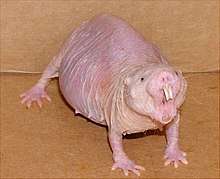
The Damaraland mole-rat (Cryptomys damarensis) is the only other eusocial mammal currently known.
Queen and gestation
The relationships between the queen and the breeding males may last for many years; other females are temporarily sterile. Queens live from 13 to 18 years, and are extremely hostile to other females behaving like queens, or producing hormones for becoming queens. When the queen dies, another female takes her place, sometimes after a violent struggle with her competitors. Once established, the new queen's body expands the space between the vertebrae in her backbone to become longer and ready to bear pups.[58]
Gestation is about 70 days. A litter typically ranges from three to twelve pups, but may be as large as twenty-eight. The average litter size is eleven.[59] In the wild, naked mole-rats usually breed once a year, if the litter survives. In captivity, they breed all year long and can produce a litter every 80 days.[60] The young are born blind and weigh about 2 grams (0.07 oz). The queen nurses them for the first month; after which the other members of the colony feed them fecal pap until they are old enough to eat solid food.
Workers
Smaller workers focus on acquiring food and maintaining tunnels, while the larger workers are more reactive in case of attacks.[61] As in certain bee species, the workers are divided along a continuum of different worker-caste behaviors instead of discrete groups.[54] Some function primarily as tunnellers, expanding the large network of tunnels within the burrow system, and some primarily as soldiers, protecting the group from outside predators. There are two main types of worker, the "frequent workers" who frequently perform tasks such as foraging and nest building and "infrequent workers" that show role overlap with the "frequent workers" but perform at a much slower rate.[62] Workers are sterile when there is no new reproductive role to fill.
Dispersers
Inbreeding is a common phenomenon among naked mole-rats within a colony. Prolonged inbreeding is usually associated with lower fitness.[63] However, the discovery of a disperser role has revealed an outbreeding mechanism in addition to inbreeding avoidance.[64] Dispersers are morphologically, physiologically as well as behaviorally distinct from colony members and actively seek to leave their burrow when an escape opportunity presents itself.[64] These individuals are equipped with generous fat reserves for their journey.[64] Though they possess high levels of luteinizing hormone, dispersers are only interested in mating with individuals from foreign colonies rather than their own colony's queen.[64] They also show little interest in working cooperatively with colony members in their natal burrow.[64] Hence, the disperser morph is well-prepared to promote the exchange of individuals as well as genetic material between two otherwise separate colonies.[64]
Colonies
Colonies range in size from 20 to 300 individuals, with an average of 75.[65]
Female mate choice
Reproductively active female naked mole rats tend to associate with unfamiliar males (usually non-kin), whereas reproductively inactive females do not discriminate.[66] The preference of reproductively active females for unfamiliar males is interpreted as an adaptation for inbreeding avoidance. Inbreeding is avoided because it ordinarily leads to the expression of recessive deleterious alleles.[67]
Diet
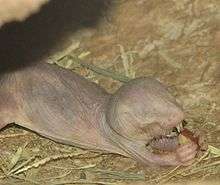
Naked mole-rats feed primarily on very large tubers (weighing as much as a thousand times the body weight of a typical mole-rat) that they find deep underground through their mining operations. A single tuber can provide a colony with a long-term source of food—lasting for months, or even years,[54] as they eat the inside but leave the outside, allowing the tuber to regenerate. Symbiotic bacteria in their intestines ferment the fibres, allowing otherwise indigestible cellulose to be turned into volatile fatty acids.
Naked mole-rats sometimes also eat their own feces.[54] This may be part of their eusocial behavior and a means of sharing hormones from the queen.[68]
Predators
Naked mole rats are primarily preyed upon by snakes—especially the Rufous beaked snake and Kenyan sand boa—as well as various raptors. They are at their most vulnerable when constructing mounds and ejecting soil to the surface.[69]
Conservation status
Naked mole-rats are not threatened. They are widespread and numerous in the drier regions of East Africa.[70]
References
- "Heterocephalus glaber". Mammalian Species. 26 December 2002. doi:10.1644/0.706.1.
- Maree, S. & Faulkes, C. (2016). Heterocephalus glaber. The IUCN Red List of Threatened Species 2016 (errata version published in 2017). doi:10.2305/IUCN.UK.2016-3.RLTS.T9987A22184136.en
- Rüppell E (1845) [1842]. "Säugethiere aus der Ordnung der Nager, beobachtet im nordöstlichen Africa". Museum Senckenbergianum: Abhandlungen aus dem Gebiete der Beschreibenden Naturgeschichte. 3: 99–101.
- Kingdon J (1 July 1984). East African Mammals: An Atlas of Evolution in Africa, Volume 2, Part B: Hares and Rodents. University of Chicago Press. p. 489. ISBN 978-0-226-43720-0.
- Woods, C.A.; Kilpatrick, C.W. (2005). "Infraorder Hystricognathi". In Wilson, D.E.; Reeder, D.M (eds.). Mammal Species of the World: A Taxonomic and Geographic Reference (3rd ed.). Johns Hopkins University Press. p. 1542. ISBN 978-0-8018-8221-0. OCLC 62265494.
- O'Riain MJ, Faulkes CG (2008). "African mole rats: eusociality, relatedness and ecological constraints". In Korb J, Heinze J (eds.). Ecology of Social Evolution. Springer. pp. 207–223. doi:10.1007/978-3-540-75957-7_10. ISBN 978-3-540-75956-0.
- Burland TM, Bennett NC, Jarvis JU, Faulkes CG (May 2002). "Eusociality in African mole-rats: new insights from patterns of genetic relatedness in the Damaraland mole-rat (Cryptomys damarensis)". Proceedings. Biological Sciences. 269 (1495): 1025–30. doi:10.1098/rspb.2002.1978. PMC 1690998. PMID 12028759.
- Welsh J (2011-10-12). "Naked Mole Rat Genome May Hold Key to Long Life". Human Health & Longevity. LiveScience. Retrieved 2013-03-23.
- Patterson BD, Upham NS (December 2014). "A newly recognized family from the Horn of Africa, the Heterocephalidae (Rodentia: Ctenohystrica)". Zoological Journal of the Linnean Society. 172 (4): 942–963. doi:10.1111/zoj.12201.
- Kingdon J (2015). The Kingdon Field Guide to African Mammals: Second Edition. Princeton, N.J.: Princeton University Press. p. 224. ISBN 978-1472925312.
- Wilson DE, Lacher TE, Mittermeier RA (2016). Handbook of the Mammals of the World Volume 6: Lagomorphs and Rodents. Barcelona: Lynx Edicions. p. 312. ISBN 978-8494189234.
- "Naked Mole-Rat". Meet Our Animals. Smithsonian National Zoo Park. Archived from the original on 2015-04-26.
- Maina, J.N.; Maloiy, G.M.O.; Makanya, A.N. (September 1992). "Morphology and morphometry of the lungs of two East African mole rats, Tachyoryctes splendens and Heterocephalus glaber (Mammalia, Rodentia)". Zoomorphology. 112 (3): 167–179. doi:10.1007/BF01633107.
- Park TJ, Reznick J, Peterson BL, Blass G, Omerbašić D, Bennett NC, Kuich PH, Zasada C, Browe BM, Hamann W, Applegate DT, Radke MH, Kosten T, Lutermann H, Gavaghan V, Eigenbrod O, Bégay V, Amoroso VG, Govind V, Minshall RD, Smith ES, Larson J, Gotthardt M, Kempa S, Lewin GR (April 2017). "Fructose-driven glycolysis supports anoxia resistance in the naked mole-rat". Science. 356 (6335): 307–311. Bibcode:2017Sci...356..307P. doi:10.1126/science.aab3896. PMID 28428423.
- Guarino, Ben (April 23, 2017) Naked mole-rats are now even weirder: Without oxygen, they live like plants. The Washington Post. This reference makes some incorrect statements, such as implying that using glucose requires oxygen but using fructose does not.
- Buffenstein, Rochelle (1 November 2015). "The Naked Mole-Rat: A New Long-Living Model for Human Aging Research". The Journals of Gerontology: Series A. 60 (11): 1369–1377. doi:10.1093/gerona/60.11.1369. PMID 16339321.
- Storz JF, McClelland GB (April 2017). "Rewiring metabolism under oxygen deprivation". Science. 356 (6335): 248–249. Bibcode:2017Sci...356..248S. doi:10.1126/science.aan1505. PMC 6661067. PMID 28428384.
- "Uncovering the secrets of the naked mole-rat". DataScience.com. 2014. Retrieved February 9, 2015.
- Daly TJ, Williams LA, Buffenstein R (April 1997). "Catecholaminergic innervation of interscapular brown adipose tissue in the naked mole-rat (Heterocephalus glaber)". Journal of Anatomy. 190 ( Pt 3) (3): 321–6. doi:10.1046/j.1469-7580.1997.19030321.x. PMC 1467613. PMID 9147219.
- Park TJ, Lu Y, Jüttner R, Smith ES, Hu J, Brand A, Wetzel C, Milenkovic N, Erdmann B, Heppenstall PA, Laurito CE, Wilson SP, Lewin GR (January 2008). "Selective inflammatory pain insensitivity in the African naked mole-rat (Heterocephalus glaber)". PLoS Biology. 6 (1): e13. doi:10.1371/journal.pbio.0060013. PMC 2214810. PMID 18232734.
- Smith ES, Blass GR, Lewin GR, Park TJ (May 2010). "Absence of histamine-induced itch in the African naked mole-rat and "rescue" by Substance P". Molecular Pain. 6 (1): 1744–8069–6–29. doi:10.1186/1744-8069-6-29. PMC 2886013. PMID 20497578.
- Delaney MA, Ward JM, Walsh TF, Chinnadurai SK, Kerns K, Kinsel MJ, Treuting PM (May 2016). "Initial Case Reports of Cancer in Naked Mole-rats (Heterocephalus glaber)". Veterinary Pathology. 53 (3): 691–6. doi:10.1177/0300985816630796. PMID 26846576.
- Seluanov A, Hine C, Azpurua J, Feigenson M, Bozzella M, Mao Z, Catania KC, Gorbunova V (November 2009). "Hypersensitivity to contact inhibition provides a clue to cancer resistance of naked mole-rat". Proceedings of the National Academy of Sciences of the United States of America. 106 (46): 19352–7. Bibcode:2009PNAS..10619352S. doi:10.1073/pnas.0905252106. PMC 2780760. PMID 19858485.
- Zimmer C (19 June 2013). "A Homely Rodent May Hold Cancer-Fighting Clues". New York Times. Retrieved 20 June 2013.
- Callaway, Ewen (19 June 2013). "Simple molecule prevents mole rats from getting cancer". Nature. doi:10.1038/nature.2013.13236.
- Briggs H (19 June 2013). "Naked mole-rat gives cancer clues". BBC News. Retrieved 21 June 2013.
- Tian X, Azpurua J, Hine C, Vaidya A, Myakishev-Rempel M, Ablaeva J, Mao Z, Nevo E, Gorbunova V, Seluanov A (July 2013). "High-molecular-mass hyaluronan mediates the cancer resistance of the naked mole rat". Nature. 499 (7458): 346–9. Bibcode:2013Natur.499..346T. doi:10.1038/nature12234. PMC 3720720. PMID 23783513.
- Azpurua J, Ke Z, Chen IX, Zhang Q, Ermolenko DN, Zhang ZD, Gorbunova V, Seluanov A (October 2013). "Naked mole-rat has increased translational fidelity compared with the mouse, as well as a unique 28S ribosomal RNA cleavage". Proceedings of the National Academy of Sciences of the United States of America. 110 (43): 17350–5. Bibcode:2013PNAS..11017350A. doi:10.1073/pnas.1313473110. PMC 3808608. PMID 24082110.
- "Breakthrough of the year 2013. Notable developments". Science. 342 (6165): 1435–41. December 2013. doi:10.1126/science.342.6165.1444. PMID 24357296.
- Delaney MA, Ward JM, Walsh TF, Chinnadurai SK, Kerns K, Kinsel MJ, Treuting PM (May 2016). "Initial Case Reports of Cancer in Naked Mole-rats (Heterocephalus glaber)". Veterinary Pathology. 53 (3): 691–6. doi:10.1177/0300985816630796. PMID 26846576.
- St Fleur N (February 19, 2016). "Two Naked Mole Rats, Seemingly Immune to Cancer, Got Cancer". New York Times. Retrieved February 20, 2016.
- Grens K (2016). "Cancer detected in naked mole rats". The Scientist. Retrieved February 15, 2016.
- Welsh JS, Traum TL (November 2016). "Regarding Mole Rats and Cancer". Veterinary Pathology. 53 (6): 1264–1265. doi:10.1177/0300985816646434. PMID 27733703.
- Cormier, Zoe (5 November 2012). "Blind mole rats may hold key to cancer". Nature. doi:10.1038/nature.2012.11741.
- "Naked mole-rat (Heterocephalus glaber) longevity, ageing, and life history". genomics.senescence.info. Retrieved 2013-11-07.
- Buffenstein R, Jarvis JU (May 2002). "The naked mole rat--a new record for the oldest living rodent". Science of Aging Knowledge Environment. 2002 (21): 7pe–7. doi:10.1126/sageke.2002.21.pe7. PMID 14602989.
- Ruby JG, Smith M, Buffenstein R (January 2018). "Naked Mole-Rat mortality rates defy gompertzian laws by not increasing with age". eLife. 7. doi:10.7554/eLife.31157. PMC 5783610. PMID 29364116.
- Buffenstein R (May 2008). "Negligible senescence in the longest living rodent, the naked mole-rat: insights from a successfully aging species". Journal of Comparative Physiology B: Biochemical, Systemic, and Environmental Physiology. 178 (4): 439–45. doi:10.1007/s00360-007-0237-5. PMID 18180931.
- Csiszar A, Labinskyy N, Orosz Z, Xiangmin Z, Buffenstein R, Ungvari Z (August 2007). "Vascular aging in the longest-living rodent, the naked mole rat". American Journal of Physiology. Heart and Circulatory Physiology. 293 (2): H919–27. doi:10.1152/ajpheart.01287.2006. PMID 17468332.
- "Ugly Duckling Mole Rats Might Hold Key To Longevity". Sciencedaily.com. 2007-10-16. Retrieved 2009-03-11.
- Pérez VI, Buffenstein R, Masamsetti V, Leonard S, Salmon AB, Mele J, Andziak B, Yang T, Edrey Y, Friguet B, Ward W, Richardson A, Chaudhuri A (March 2009). "Protein stability and resistance to oxidative stress are determinants of longevity in the longest-living rodent, the naked mole-rat". Proceedings of the National Academy of Sciences of the United States of America. 106 (9): 3059–64. Bibcode:2009PNAS..106.3059P. doi:10.1073/pnas.0809620106. PMC 2651236. PMID 19223593.
- "Proposal to Sequence an Organism of Unique Interest for Research on Aging: Heterocephalus glaber, the Naked Mole-Rat". Genomics.senescence.info. Retrieved 2009-04-30.
- "Naked Mole-Rat Database". Naked Mole-Rat Database 2011. Retrieved 5 July 2011.
- "Naked Mole-Rat Genome Resource". Naked Mole-Rat Genome Resource 2011. Retrieved 5 July 2011.
- Kim EB, Fang X, Fushan AA, Huang Z, Lobanov AV, Han L, Marino SM, Sun X, Turanov AA, Yang P, Yim SH, Zhao X, Kasaikina MV, Stoletzki N, Peng C, Polak P, Xiong Z, Kiezun A, Zhu Y, Chen Y, Kryukov GV, Zhang Q, Peshkin L, Yang L, Bronson RT, Buffenstein R, Wang B, Han C, Li Q, Chen L, Zhao W, Sunyaev SR, Park TJ, Zhang G, Wang J, Gladyshev VN (October 2011). "Genome sequencing reveals insights into physiology and longevity of the naked mole rat". Nature. 479 (7372): 223–7. Bibcode:2011Natur.479..223K. doi:10.1038/nature10533. PMC 3319411. PMID 21993625.
- Keane M, Craig T, Alföldi J, Berlin AM, Johnson J, Seluanov A, Gorbunova V, Di Palma F, Lindblad-Toh K, Church GM, de Magalhães JP (December 2014). "The Naked Mole Rat Genome Resource: facilitating analyses of cancer and longevity-related adaptations". Bioinformatics. 30 (24): 3558–60. doi:10.1093/bioinformatics/btu579. PMC 4253829. PMID 25172923.
- Yu C, Li Y, Holmes A, Szafranski K, Faulkes CG, Coen CW, Buffenstein R, Platzer M, de Magalhães JP, Church GM (2011). "RNA sequencing reveals differential expression of mitochondrial and oxidation reduction genes in the long-lived naked mole-rat when compared to mice". PLOS ONE. 6 (11): e26729. Bibcode:2011PLoSO...626729Y. doi:10.1371/journal.pone.0026729. PMC 3207814. PMID 22073188.
- MacRae SL, Croken MM, Calder RB, Aliper A, Milholland B, White RR, Zhavoronkov A, Gladyshev VN, Seluanov A, Gorbunova V, Zhang ZD, Vijg J (December 2015). "DNA repair in species with extreme lifespan differences". Aging. 7 (12): 1171–84. doi:10.18632/aging.100866. PMC 4712340. PMID 26729707.
- Bernstein H, Payne CM, Bernstein C, Garewal H, Dvorak K (2008). "Cancer and aging as consequences of un-repaired DNA damage Archived 2014-10-25 at the Wayback Machine". In: New Research on DNA Damages (Editors: Honoka Kimura and Aoi Suzuki) Nova Science Publishers, Inc., New York, Chapter 1, pp. 1-47. open access, but read only ISBN 1604565810 ISBN 978-1604565812
- Young AJ, Bennett NC (November 2010). "Morphological divergence of breeders and helpers in wild Damaraland mole-rat societies". Evolution; International Journal of Organic Evolution. 64 (11): 3190–7. doi:10.1111/j.1558-5646.2010.01066.x. PMID 20561049.
- Jarvis JU, Bennett NC (1993). "Eusociality has evolved independently in two genera of bathyergid mole-rats — but occurs in no other subterranean mammal". Behavioral Ecology and Sociobiology. 33 (4): 253–260. doi:10.1007/bf02027122.
- Park, T.J.; Lewin, G.R.; Buffenstein, R. (2010). "Naked Mole Rats: Their Extraordinary Sensory World". Encyclopedia of Animal Behavior. pp. 505–512. doi:10.1016/b978-0-08-045337-8.00152-2. ISBN 978-0-08-045337-8.
- Sherman PW, Jarvis J, Alexander R (1991). The Biology of the Naked Mole-rat. Princeton, N.J.: Princeton University Press. ISBN 978-0691024486.
- Dawkins R (2006) [1976]. The Selfish Gene (30th anniversary ed.). Oxford University Press. ISBN 978-0-19-286092-7.
- Jarvis J (May 1981). "Eusociality in a Mammal: Cooperative Breeding in Naked Mole-Rat Colonies". Science. 212 (4494): 571–573. Bibcode:1981Sci...212..571J. doi:10.1126/science.7209555. JSTOR 1686202. PMID 7209555.
- Marshall M (17 October 2014). "Eight ugly animals we should save anyway". BBC Earth. Retrieved 3 January 2015.
- Sherman, Paul W.; Jarvis, Jennifer U. M.; Braude, Stanton H. (August 1992). "Naked Mole Rats". Scientific American. 267 (2): 72–79. Bibcode:1992SciAm.267b..72S. doi:10.1038/scientificamerican0892-72. JSTOR 24939178.
- "San Diego's Animals. Mammals: Naked Mole-rat". Sandiegozoo.org. Retrieved 2013-03-23.
- Counting mole-rat mammaries and hungry pups, biologists explain why naked rodents break the rules, Roger Segelken, Cornell News, August 9, 1999
- Piper R (2007). Extraordinary Animals: An Encyclopedia of Curious and Unusual Animals. Westport, Conn: Greenwood Press. ISBN 978-0-313-33922-6.
- Morelle R (May 5, 2010). "Meet the 'sabre-toothed sausage'". BBC News.
- Jarvis JU (1981). "Eusociality in a Mammal: Cooperative Breeding in Naked Mole-Rat Colonies". Science. 212 (4494): 571–573. Bibcode:1981Sci...212..571J. doi:10.1126/science.7209555. JSTOR 1686202. PMID 7209555.
- Bengtsson, B.O. (August 1978). "Avoiding inbreeding: at what cost?". Journal of Theoretical Biology. 73 (3): 439–444. doi:10.1016/0022-5193(78)90151-0. PMID 692150.
- Bromham, Lindell; Harvey, Paul H (September 1996). "Behavioural ecology: Naked mole-rats on the move". Current Biology. 6 (9): 1082–1083. doi:10.1016/S0960-9822(02)70671-4. PMID 8805352.
- The Naked Truth About Mole-Rats Archived 2009-07-13 at the Wayback Machine, Jill Locantore, Smithsonian Zoogoer, May/June 2002
- Clarke FM, Faulkes CG (October 1999). "Kin discrimination and female mate choice in the naked mole-rat Heterocephalus glaber". Proceedings. Biological Sciences. 266 (1432): 1995–2002. doi:10.1098/rspb.1999.0877. PMC 1690316. PMID 10584337.
- Charlesworth D, Willis JH (November 2009). "The genetics of inbreeding depression". Nature Reviews. Genetics. 10 (11): 783–96. doi:10.1038/nrg2664. PMID 19834483.
- Reardon, Sara (20 October 2015). "Poo turns naked mole rats into better babysitters". Nature. doi:10.1038/nature.2015.18606.
- Mammals of Africa, Volume III. Bloomsbury Natural History. February 2013. p. 670. ISBN 9781408122570.
- International Union for Conservation of Nature Red List: Heterocephalus Glaber listed as "least concern".
Further reading
- Ciszek, Deborah (1999). "Heterocephalus glaber, naked mole rat". Animal Diversity Web. Retrieved 22 January 2010.
- "Heterocephalus glaber: Cooperation is Key". Brookfield Zoo. Archived from the original on 6 December 2010. Retrieved 22 January 2010.
- "Naked Mole Rat". Chicago Zoological Society. Retrieved 26 April 2017.
- Baskauf, Steve (2003). "Naked mole rat (Heterocephalus glaber) images". Bioimages at Vanderbilt University. Retrieved 22 January 2010.
- Bryner, Jeanna (October 2006). "Naked Mole-rats Hold Clues to Human Aging". LiveScience. Retrieved 22 January 2010.
- Sherman PW, Jarvis JU (November 2002). "Extraordinary life spans of naked mole-rats (Heterocephalus glaber)". Journal of Zoology. 258 (3): 307–311. doi:10.1017/S0952836902001437.
- Shuster G, Sherman PW (1998). "Tool use by naked mole-rats". Animal Cognition. 1 (1): 71–74. doi:10.1007/s100710050009.
- Choi CQ (January 2008). "Strange Creature Immune to Pain". LiveScience. Retrieved 22 January 2010.
- "Small Mammals (with a naked mole-rat webcam)". Smithsonian National Zoological Park. Retrieved 22 January 2010.
External links
| Wikimedia Commons has media related to Naked Mole Rat. |
| Wikispecies has information related to Naked Mole Rat |
- View the hetGla2 genome assembly in the UCSC Genome Browser.
